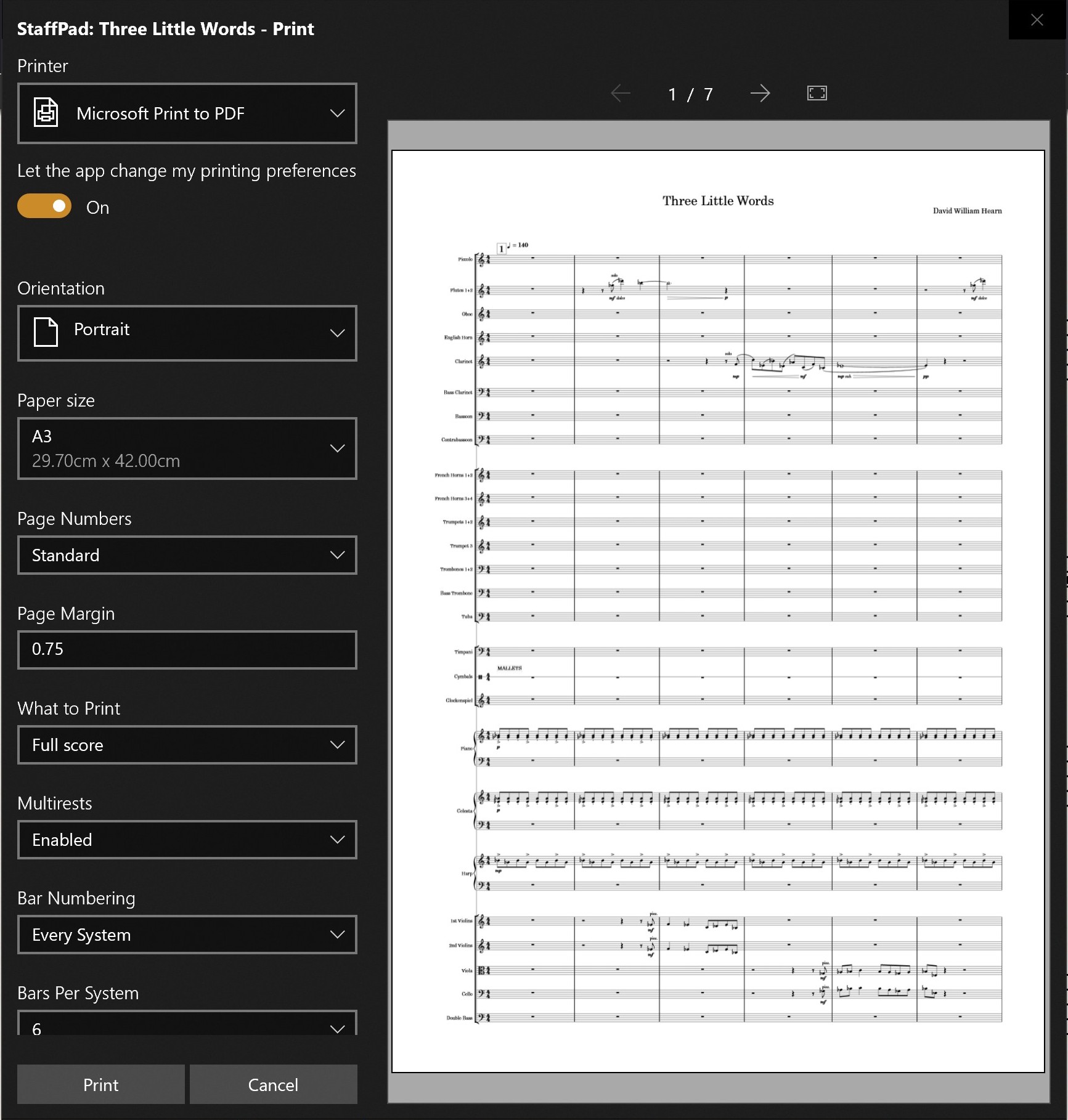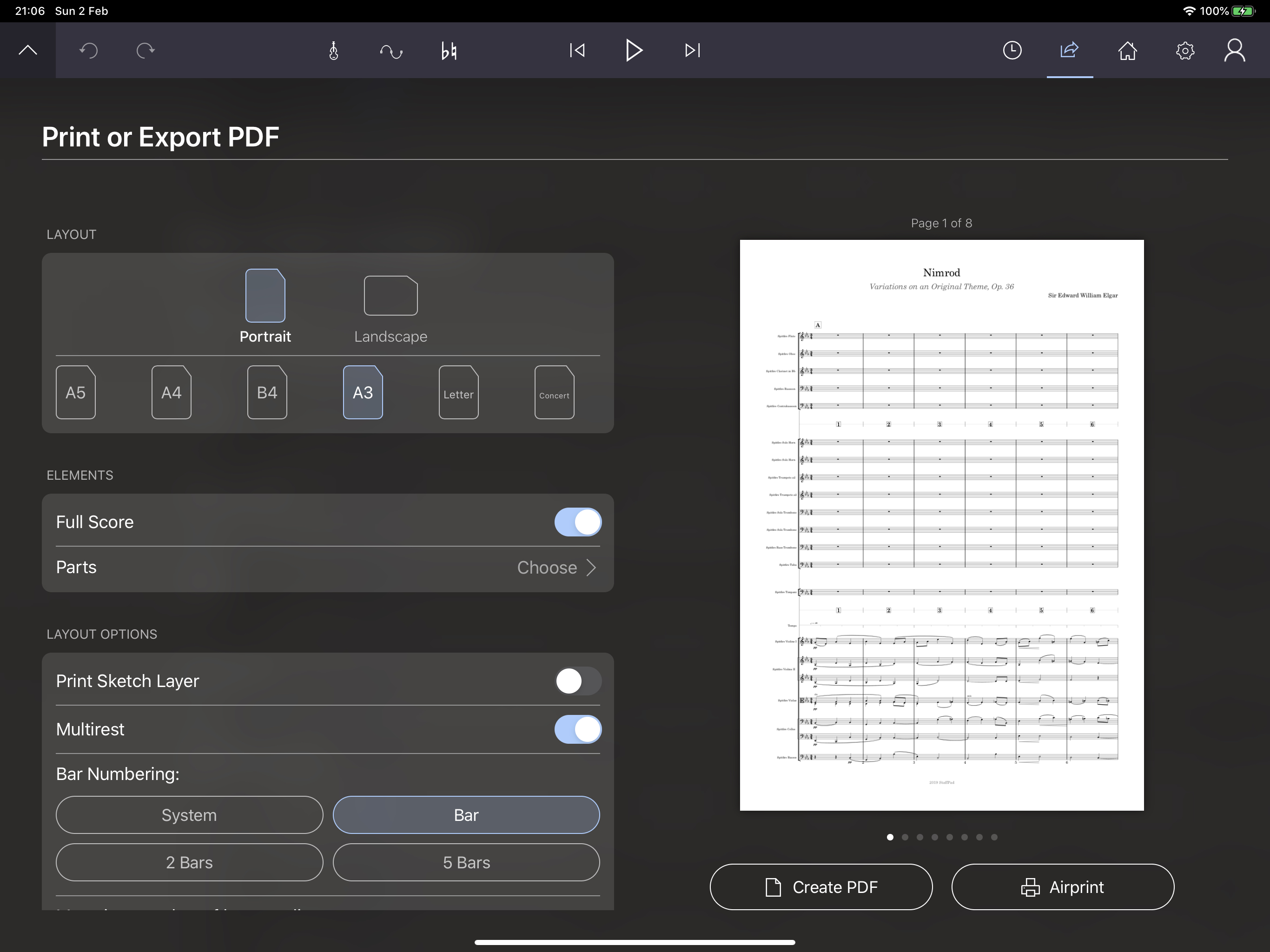StaffPad was designed to be used with StaffPad Reader, which displays parts in realtime and in a responsive format, based on each device's screen size, orientation, resolution and zoom preference. It'll update with any changes, and synchronise your playback and page turns for you. It's all very clever...
...Yet, sometimes, you just need to print it out!
For these occasions, StaffPad also has a traditional print engine, which is designed to generate and layout the printed score and parts automatically. There are a couple of differences here between iPad and Windows:
Windows
For Windows, go to Command bar> Print ![]()
The Windows Print dialog will appear, with some options specific to the score layout:

Here you’ll find various options. These options will vary depending on your printer’s capabilities. Tap on More settings to access even more detailed printing options as provided by your printer driver.
Creating a PDF
On Windows, if you wish to create a PDF of your score, you must use the Microsoft PDF Printer Driver in order to write a PDF file. Once you select this printer driver, and your print options, when you press the Print button, you'll see a file dialog. From here, you can choose where to save your PDF file.
iPad
The iPad doesn't really have the same concept of a "print" dialog with app-specific options, so we created a special screen for the purpose.

The same layout options are present on both iPad and Windows, but they are presented in a different way.
You can scroll the column on the left vertically to view and select your layout options. Swipe the page preview left and right to preview the pages that will be printed.
To print or export specific parts, tap the "Choose >" text under the Parts section, and toggle on which parts you wish to include in the export. You can tap the "All Parts" option to quickly toggle all the parts in the score.
To physically print the score, tap the AirPrint button. An additional iOS control will pop up, allowing you to choose your printer, which pages you want to print, and any printer specific options (for example, which tray you have the paper loaded in).
Creating a PDF
To create a PDF on iPad, just tap the "Create PDF" button. You can then choose to share the PDF to other apps, AirDrop or email it to people and so on.
Although StaffPad doesn’t offer many of the advanced page layout and print options like those provided by desktop scoring programs, you will be able to customize your printout somewhat:
- Orientation: Choose either Portrait or Landscape
- Size: Choose from a variety of standard page sizes
- Page Numbers: Choose from None, Standard, or Roman Numerals
- Page Margin: Enter your page margin here (applies to all sides of the document)
- What to Print: Choose from Full score, Full score + all parts, All parts,or choose any particular part from the dropdown list.
- Multirests: Choose Enabled or Disabled; if enabled, StaffPad will include multirest bar number ranges under the multirest
- Maximum Number of Bars Per Line: Choose how many bars you'd like, as a maximum ,per system of music. StaffPad won't always cram this many bars in per system if it can't be done, but it'll aim for this as a maximum.
- Print Sketch Layer: Choose Show or Hide to show any drawings made in the Sketch Layer
- Print Scale: Select the percentage by which StaffPad should scale the music on the page, in preset percentages from 50% from 200%. If you select a percentage that is too large for StaffPad to comfortably fit the music on the page, it will scale the music by the largest allowable percentage, depending upon the paper size.
- Lyric Size: Choose from Small, Medium, or Large to adjust to size that lyrics appear in the score when printed. This won’t affect the size that lyrics display while working in StaffPad.
Keep in mind that if Exclude from parts is checked in an instrument’s Staff control, it will not print in the full score, and it won't be visible in the parts list.
StaffPad’s default output is quite clear, well-spaced and readable at a basic level. Should you need finer control from within a desktop scoring program, export your score to MusicXML to work with it further in one of those programs.